 |
Report from Siggraph 98: The Art Gallery
25th International Conference on Computer Graphics
and Interactive Techniques
Orlando, Florida - July 21-23, 1998
_____________________
Kristin Cully
"As cyberspace with its virtuality
races towards the future, there is a cry for the hand. In linking to cyberspace,
where is the touch, the tactility, the physicality of experience? Touchware
is the lens through which we envision the future. This exhibition embraces
the interface between computing and user as the territory of art."
1
|
Joan Truckenbrod
Art Gallery: Touchware Chair
Electronic Art and Animation Catalog
Siggraph 98
|
In the midst of SIGGRAPH, the international conference featuring thousands of square feet of exhibition space
filled with the latest and greatest in computer graphics and interactive technologies, is the art gallery which
this year featured Touchware,a juried show emphasizing the element of "touch" at the interface
between human and machine. Touchware Chair Joan Truckenbrod explains that the exhibit explores both
the idea of psychologically "being in touch" as well as the physicality of touch.2 In their radically
different approaches to the idea of touch at the interface between human and machine, the following selected
installation projects provide a glimpse into the murky waters where the realm of what is referred to as
"interactive art" resides.
Rebecca Allen and The Emergence Team - The Bush Soul
UCLA
The concept behind this piece derives from the West African belief that a person has more than one soul.
One of these alternate souls is a type of soul that resides within a wild animal of the bush, while that animal
also maintains a life of its own. In the interactive environment of The Bush Soul,the role of avatars and
their relationship to humans is explored. Far from Africa’s bush, though only miles from Disney’s
simulated African bush, here the avatar carries the participant’s "bush soul" into the "virtual
bush" 3 as represented by the three screen projection system facing the human participant who controls the
navigation of the avatar. According to Allen, the team is "interested in setting up a relationship (which is)
abstract... (and has ) an unfamiliar alien feel as well as an organic feel." 4 What is important here, is the idea
that "life" is attributed to everything in the virtual environment. Even the camera is alive: "We
think of the camera as another creature following you," explains Loren McQuade, Emergence Team software
designer. 5 Communication in this environment is nonverbal with feeling or emotion being evoked not through
the use of language, but by the movements, gestures, and sounds of the characters in response to each other and
the environment.

The Bush Soul,1998
|

The Bush Soul,1998
|
As with the wild animal, the avatar while theoretically carrying the human bush soul has its own set of behaviors;
the human participant offers guidance to the avatar, but ultimately the avatars own set of behaviors might override the
participants instructions. "Complex social environments can emerge from the interaction of simple behaviors",
6 mentions Allen. While the artists’ control over determining the final makeup of this environment is limited,
thus supporting the idea that "emergence" is possible, it is not clear to the user that the user’s interaction has
any influence on the environment besides navigational.
Appropriating the West African idea of the bush soul, in order to create its virtual equivalent, seems problematic
as anything more than a conceptual springboard for this project. The reliance on this idea - perhaps deeply spiritual
within the particular West African culture to which it belongs - to fully carry the project appears to be a conceptual crutch and a
meager attempt to incorporate the cultural other.
In the end perhaps The Bush Soul is simply an artistic attempt at providing a showcase for the
"Emergence" technology - " a PC -based real-time 3D Software system that supports an active,
responsive, networked, virtual world"7 - that Rebecca Allen together with the Emergence Team, a group
of UCLA computer science and design students, have developed.
Tammy Knipp - Case Study 309
After passing Case Study 309 several times, always intrigued by the constant line of participants waiting
to sprawl themselves on the floor beneath a very heavy looking black box dangling from four rather light gauge chains,
and precariously heaving and lurching directly above an upturned face, I decided to stop and pay closer attention. Here,
Knipp had introduced perceived "risk" into the interactive art equation - and it was working.
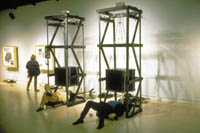
Case Study 309,1996
|
Finally my curiousity was sufficiently mustered to entice me to stand in line in order to figure out what this was
all about. Prostrate, face up, it was finally my turn to experience the machinery lurching close overhead. What had
been merely a black box, was also a video monitor. After viewing the video it was time to give the next visitor an
opportunity to question theirrole in this interactive piece.
Relative to the interest evoked by viewing the overall spectacle of the installation as a passerby, the video itself
was of little consequence. "Touch" it turned out had no place here. Rather the participant was a hostage of
sorts, completely without opportunity to actively participate with the piece, but instead was acted upon. The
viewer’s role was that of the observer no matter where one stood; as a passerby I watched the whole spectacle,
including the phenomenon of ". Waiting in line" that had been incorporated into the work itself; waiting in
line, now within the project, I watched the tense body under the precarious lurching box anticipating my own
experience there; finally lying beneath the heaving box watching the video, I didn’t leave nor was I allowed
to expand upon my role as observer.
In all these positions the viewer is also an integral part of the work. The entire staging of Case Study
309was a performance with viewers, both outside and inside the piece, as the willing yet oblivious performers
at the interface between human and machine.
Sensorium - BeWare02
Sensorium’s BeWare02 offered an intriguing approach to dynamically mapping world temperature data
gathered by the National Oceanic & Atmospheric Administration’s (NOAA) polar orbital satellite. According
to the speed at which the satellite was travelling, photographic images collected by the NOAA satellite were projected
and updated on a plate atop the 4 inch by 6 foot surface of a waist-high wall. The infrared images were analyzed by
their temperature data which was used to control Peltier devices attached to the underside of the plate. In running
one’s hand over the smooth plastic plate, in effect, one ran one’s hand over the surface of the earth
perceiving tactically the temperature change encapsulated as a longitudinal band stretching between the North and
South poles.

BeWare02:satellite,1997
|
The collaborative team composing Sensorium is openly unconcerned about whether its projects reside in the
domain of art, science, or education. An especially innovative approach to data mapping, this hybrid project allows
the viewer to cross from one field of inquiry to another. In delivering information impossible to read at its
ordinary magnitude, this piece was something akin to a tactile version of the Eames’ 1970s film "Powers of
Ten". Sensorium’s approach to data mapping with BeWare02, involving a unique approach to issues of
scale, offered the user not only the opportunity to perceive the living planet in a new way, but also offered a
tactile experience of the living network, the Internet.
David Small and Tom White - Stream of Consciousness
MIT ACG group - The Media Lab
Stream of Consciousness incorporated a "liquid haptic interface", a hardware device used to interact with a
word association database, into an abbreviated Japanese garden plot. Testifying to the popularity of this piece
during the four day art gallery show, the garden’s bench where visitors stopped to rest and interact with
the piece was rarely empty. By applying pressure to a soy sauce filled bladder, the primary feature of the
liquid haptic interface, the user manipulated the flow of words projected onto the stream
of water flowing through the garden plot. The resulting poetic associations were the result of a
collaboration between human and machine.
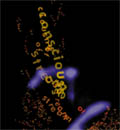
Stream of Consciousness,1997
|
The use of the miniature garden plot was reminiscent of similarly scaled plots found in the garden show section of
the local county fair. Neither White nor Small seemed aware of this association, preferring to characterize Stream of
Consciousness as a place to meditate. This piece exhibited some intriguing technology and at first glance it
seemed solid. However, upon delving deeper, fissures in the conceptual makeup of Stream of Consciousness
became apparent. When probed on the connection between meditation and language, neither artist had a response as
to how they related and claimed that this was the first time this aspect of their piece had been questioned. 8
(Considering the popularity of this piece, I wondered what had been asked.) According to the exhibition catalog,
the intentionality of the piece was clear: "The project attempts to bring the computer into the garden in
harmony with stone, water, and plant materials."9 A follow up question to this statement might be: Why?
The Center for Metahuman Exploration - Project Paradise
Carnegie Mellon University
The Center for Metahuman Exploration was presumably not as interested in
exploiting the telepresent robotic functioning of Project Paradise to attract viewer attention as presenting the spectacle
of real time video feed of one naked person touching another. The video display monitor
stood at the heavily trafficked crossroads of the Touchware and Enhanced Realities shows, positioned
immediately outside the concealed installation whose inside it was revealing. Word of this captivating footage
apparently traveled very quickly around SIGGRAPH - well beyond the temporary walls of the art gallery, as was
noted by several of the video viewers on various occasions.
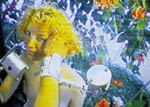
Project Paradise,1997
|
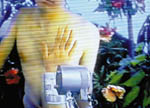
Project Paradise,1997
|
While Project Paradise’s Adam and Eve, male and female, characters were contained in an upright
cylindrical, approximately 6 foot diameter holding tank, a solid line of participants waited at one of two unmarked
telephone booth style structures placed 50 feet on either side of the tank. For the better part of the exhibition,
the lines were predominantly, if not entirely, male in their makeup. When questioned on the significance of this
occurrence, a representative of the The Center for Metahuman Exploration commented that "this is because visitors
to SIGGRAPH are mainly male" 10 - according to him this demographic was correlative with the visitorship to
SIGGRAPH and not in any way due to the content of the piece or the perceived participation of the user in this project.
Upon finally arriving in one of Project Paradise’s control booths, a participant would be able to
control the arm movement of either the Adam or Eve character depending on which line they had chosen to stand in
and subsequently which booth they had found themselves in. While the user didn’t control the hand movement,
but only general arm movements of the individual in the holding tank, the characters took it upon themselves to
maneuver their fingers. At times one of the character’s arms would be maneuvered toward the other without
being close enough to touch, and the character’s fingers would stretch eagerly toward their tank
companion’s body without reaching it. Likewise these characters exhibited what might be termed
"emotion"; most often the tank companions’ expressions shifted between bored banal to
sensual anticipatory. Thus, like the avatars in The Bush Soul, these avatars were already programmed
with their own behaviors. According to the Touchware gallery write-up for this piece these characters are avatars,
which the human participants inhabit. "Through the empathy invoked by the human avatars, Project Paradise
extends traditional telepresence to engage in sending and receiving human will and emotion."11 The sincerity
and import evident in the exhibition catalog description of this piece doesn’t let on to the obvious element of
humor apparent here.
Keith Roberson - Litt’l Havoc
In contrast to all the elaborate funding driven projects brought to SIGGRAPH by the likes of MIT, UCLA, Carnegie
Mellon, Ars Electronica, was Litt’l Havoc. Keith Roberson collected "stuff", low tech stuff, all
free, in order to devise his response to how most interactive art is put together - that is, as he related,
"it’s reliance on supreme technology, over stimulation, and austere, formal qualities"12 Roberson
referred to his piece as "dumpster art" and freely related its zero budget and no financial support status.
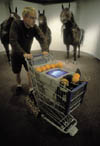
Litt'l Havoc,1998
|
Litt’l Havoc’s computer interface consisted of a monitor situated face-up in a shopping cart and
surrounded by various odds and ends, including oranges. User interaction involved pushing the cart which in turn
manipulated an upside down mouse/tennis ball apparatus. This apparatus would cause the onscreen program, featuring the artist pushing
his own cart through "absurd environments of old post cards, NASA space imagery, and historic street scenes of
Florida " 13 to change.
In a more general light, the shopping cart and its associations with consumerism as well as being a "home" for the homeless
can be seen as a bridge between the worlds of the technology "haves"
and "have-nots" thus drawing attention, in its own Litt’l way, to an issue otherwise
unaddressed at SIGGRAPH.
Maurice Benayoun - World Skin
Musical Composition by Jean-Baptiste Barriere
After waiting in yet another line, I entered the makeshift room along with seven others to embark on my first
experience in a CAVE. Upon donning a pair of 3D glasses the docent provided us with instructions, which included
relating that one of us would be the "bus driver" while the others would act as "photographers".
All grasped their appropriate devices - camera or, in the case of the driver, the joystick - and the journey began.
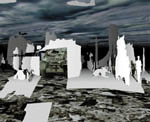
World Skin,1997
|
While the driver determined the course by which the entire group navigated the terrain, photographers were busy
snapping photos in what appeared to be a war torn landscape, bleak, muted, eerily shifting between two dimensional
surfaces and three dimensional spaces; moving through the 3D environment, we passed objects only to find that they
were without dimension. With their cardboard cutout appearance, they lacked depth both literally and figuratively;
whether the photo captures anything more than the surface of what occurs in such a landscape became a probing
question.
As the photographers dutifully snapped photos, no doubt with as much vigor as nearby Disney’s African Safari
tourists from their bus simultaneously did, the landscape began to disappear; it was slowly blotted away by
white space. The camera here acted as an eraser, or more accurately a weapon of extinguishment. In this ravaged
landscape "shooting the camera" and "shooting a gun" was correlative - the relationship between
the photographic image and death is wonderfully brought to the fore by World Skin. As well, the privileged
status of the image of the real over the "real" is made readily clear. The viewer/ participant is
implicated in the "death" of the landscape even after they’ve departed the CAVE. Upon exiting the
CAVE participants were able to retrieve the "photos" they’d taken; a printer provided the images,
i.e. the extinguished elements, of the session’s photo shoot.
_________________________________________________
In the context of the art gallery, presumably art is found. Though, even with the authority that this context lends
to labeling something as art, it is unclear as to how some of the work found in Touchware might be deemed art
rather than something else. The murkiness of the territory known as "interactive art" becomes further
obscured when these pieces are set against interactive encounters found at nearby Disney’s Wild Kingdom with
its simulated African Safari complete with simulated 1000 year old Baobob trees, hippos, and a poacher-capturing
adventure. Disney City provided further exploration of the relationship between humans and avatars with such treats
as "human pinball", where graphical pinballs acting as avatars for the human participants could be
maneuvered using one’s entire body, and Aladdin’s Magic Carpet ride, where the human participant could
explore and interact in a virtual environment represented by an avatar in the form of a monkey. These experiences
provided an interesting benchmark by which to compare human participation in "interactive art" as opposed
to the interaction between human and machine that is not framed by the art context.

Kilimanjaro Safaris,1998
Disney's Animal Kingdom
(Note: 1000 year old Baobab Tree in background.)
|
1. Electronic Art and Animation Catalog - p. 2
2. Ibid
3. "The Bush Soul" press release
4. Interview with Rebecca Allen - 7/23/98
5. Interview with Loren White - 7/23/98
6. Interview with Rebecca Allen - 7/23/98
7. UCLA Press Release
8. Discussion with David Small and Tom White - 7/24/98
9. Electronic Art and Animation Catalog - p.50
10. In discussion with representative from The Center for Metahuman Exploration 7/22/98
11. Electronic Art and Animation Catalog - p.54
12. Interview with Keith Roberson - 7/23/98
13. Electronic Art and Animation Catalog - p. 42
Touchware jury:
Annick Bureaud - Editor, IDEA/International Directory of
Electronic Arts
Stephen A. Benton - Director, Center for Advanced Visual Studies, MIT
Deanna Morse - Professor, Grand Valley State University, Allendale, Michigan
Jane Stevens - Curator, Illinois Art Gallery, Chicago Illinois
|